 Legrand S.A. is one of the world’s biggest makers of designer light switches. These include “home automation” light switches, meaning that they connect to a home automation system, so that for example you can control your light switches from anywhere in the world, and you can turn them on and off using Alexa or Google Home. These light switches rely upon a “cloud” called Eliot which is hosted by Legrand.
Legrand S.A. is one of the world’s biggest makers of designer light switches. These include “home automation” light switches, meaning that they connect to a home automation system, so that for example you can control your light switches from anywhere in the world, and you can turn them on and off using Alexa or Google Home. These light switches rely upon a “cloud” called Eliot which is hosted by Legrand.
By 2016, some 22 million Legrand home-automation light switches had been placed into service around the world. In about 2020, I purchased about $5K worth of Legrand home-automation light switches for my home.
In about 2021, Legrand abandoned its customers, allowing its Eliot cloud to fall apart. Now, in 2025, it is rare for the Eliot cloud to handle any function (for example asking Alexa to turn a light on) reliably. If you are a home owner with a houseful of Legrand home-automation light switches, you are likely as disappointed as I am to realize that the purported benefits of the “home automation” qualities of the light switches are gone.
I am delighted to tell you that due to the hard work of two very nice people named Ross Tyler and Alexander Hudek, there is a way to survive despite the loss of the Eliot cloud. It involves setting up Home Assistant in your home.
This is not the first time that a big, well-known company abandoned its customers by allowing a “cloud” to fail. In 2022, for example, as I reported here, D-Link shut down its cloud for its smart plugs and other home automation devices.
Figure 1 below shows, in functional-block-diagram format, a typical legacy home automation system as provided by Legrand and other companies. For decades, the general rule has been that each maker of devices for use in an automated home sets up its own ecosystem. (I suggest printing out Figure 1 as well as Figure 2 below, to keep them handy when reading the next few paragraphs.) Each ecosystem has a “last 50 feet” proprietary communications link, followed by a proprietary hub or controller, followed by a proprietary cloud, followed by a proprietary mobile phone app.
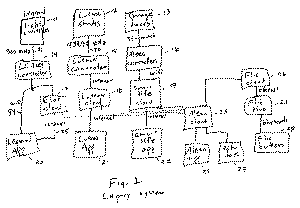
The “last 50 feet” proprietary communications link. So for example a group of, say, forty Legrand light switches 11 will communicate via link 31 which is called “RFLC” (Legrand radio frequency lighting control). The link operates in the 900-MHz ISM frequency band and connects to an LC7001 controller 14. A group of, say, forty Lutron window shades 12 will communicate via link 32 which is called “Radio RA 2”. The link operates at 433.92 MHz and connects to a RA2 Select hub 15. A group of garage doors will communicate via link 33 which is ordinary low-voltage DC wiring to Moes controllers 16. (As time goes on, all such proprietary “last 50 feet” links such as 31, 32, 33 will hopefully eventually get replaced by links according to a new open standard called “Matter“, see my blog article.)
The proprietary hub or controller. As just described, each ecosystem has its own proprietary hub or controller such as 14 or 15. For example the proprietary controller in Legrand’s ecosystem was the LC7001 controller 14, seen here.
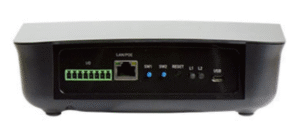
(As time goes on, all such proprietary hubs and controllers such as 14 and 15 will hopefully eventually get replaced by new open-standard “Matter” controllers, see my blog article.)
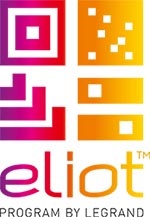 The proprietary clouds. As described above, each ecosystem has its own proprietary cloud such as clouds 17, 18 and 19. In the case of Legrand, it initially made use of a cloud called “Artik” hosted by Samsung, that launched in early 2016. But Samsung shut down the Artik cloud on December 16, 2018. This led Legrand to construct its own new proprietary cloud called “Eliot” (shown in Fig. 1 as number 17, with logo at right). Legrand proclaimed to anyone who would listen that Eliot would be the best cloud ever (see press kit). This forced Legrand’s customers to migrate from the Artik cloud to the Eliot cloud which was, of course, a lot of work.
The proprietary clouds. As described above, each ecosystem has its own proprietary cloud such as clouds 17, 18 and 19. In the case of Legrand, it initially made use of a cloud called “Artik” hosted by Samsung, that launched in early 2016. But Samsung shut down the Artik cloud on December 16, 2018. This led Legrand to construct its own new proprietary cloud called “Eliot” (shown in Fig. 1 as number 17, with logo at right). Legrand proclaimed to anyone who would listen that Eliot would be the best cloud ever (see press kit). This forced Legrand’s customers to migrate from the Artik cloud to the Eliot cloud which was, of course, a lot of work.
It is sad to read the press kit now, seven years after the launch of Eliot. The press kit has hero shots of top executives of Legrand, each quoted breathlessly about how wonderful the Eliot cloud will be. The press kit explains the clever naming of Eliot, with the “EL” standing for electricity, and the “IOT” standing for “internet of things”. The then Chairman of the Board and CEO of Legrand, Gilles Schnepp, was quoted in the press release:
Buildings are at the heart of the Internet of Things revolution.
He jumped ship five years ago to join Danone, the world’s biggest maker of yogurt. The President of Legrand USA, John Selldorff, is quoted in the press release:
Legrand is built-in, not simply plugged in. We’re integrated into virtually every space where people live and work.
He retired from Legrand in early 2024. Legrand’s Chief Information Officer, Roger Czuchra, explains in the press release that:
Privacy and data security are at the core of the Eliot program.
He departed in May of 2019 for Centric Brands, a maker of apparel and jewelry. Legrand’s Chief Marketing Officer, Steve Schoffstall, said in the press kit:
Eliot is driving innovation. We are innovating not just to add connected interfaces to our current offering, but also to develop natively-connected devices.
He retired from Legrand in 2022. Brian Dibella, then the President of Legrand’s Electrical Division, had his hero shot in the press kit, but was not quoted as saying anything about Eliot. He is now the President and CEO of Legrand. I wrote a letter to him just now, asking him to fix the Eliot cloud.
The proprietary mobile phone apps. Each ecosystem has its own proprietary app, for example the Legrand app 20, the Lutron app 21, and the Smart Life app 22. This means, for example, that if you first get the idea to turn a light on or off, you must remember which app is the correct one for lighting, open that app, log in, and turn the light on or off. If you next get the idea to raise or lower a shade, you must remember which app is the correct one for shades, open that app, log in, and raise or lower the shade.
Of course each company that launched a “last 50 feet” communications protocol with an associated proprietary hub or controller, and that launched an associated proprietary cloud, and that launched an associated proprietary mobile phone app (actually two apps, one for Android and another for Apple), desperately hoped that some how its ecosystem would come to be adopted by every other company. This has never worked, but it is what each company hoped.
Having set forth this background, we can now turn to Legrand’s betrayal of its homeowner customers.
Legrand’s first betrayal. A first step in Legrand’s betrayal of the homeowners who had purchased 22 million of its home automation light switches was its discontinuation in 2021 of the Legrand LC7001 controller. At a minimum this step injected great uncertainty in the lives of the hundreds of thousands of homes that relied upon an LC7001 controller to control the Legrand light switches. If the LC7001 controller in a particular home were to fail, this would turn each $140 Legrand home automation light switch into a $1.50 generic light switch. It is now very hard, in 2025, to purchase an LC7001 controller — it is an expensive collector’s item on eBay. (I have purchased a spare LC7001 controller for my home.)
Legrand’s second betrayal. The second step in Legrand’s betrayal of the homeowners who had purchased 22 million of its home automation light switches was its decision to allow its Eliot cloud (item 17 in Fig. 1) to fall into disrepair. As described above, the Eliot cloud is now very unreliable. For example suppose you have set up a link between the Alexa cloud 23 and the Eliot cloud 17 (which is done by “turning on a skill” in Alexa). And suppose you have set up an Echo Dot 25 so that you can say “Alexa, please turn on the kitchen light”. What should happen next is that the Echo Dot 25 sends your request to the Alexa cloud 23, which passes the request to the Eliot cloud 17, which is supposed to pass the request to the LC7001 controller 17, which would then pass the request vial 900-MHz link 31 to the kitchen light switch.
The problem is that if you do this “Alexa, please turn on the kitchen light” experiment twenty times, it will succeed only maybe twice. The astonishing failure rate is, according to a Legrand tech support person, thought to be somewhat dependent upon the time of day. It is thought that in the early evening, people get home from work and it is dark out and they ask Alexa to turn on their kitchen light. And this is thought to explain why the success rate for such an experiment is even lower in the early evening.
A second way that this disrepair of the Eliot cloud 17 harms homeowners arises is if the homeowner happens to be away from home, in which case the Legrand app 20 connects “remotely” (through Eliot cloud 17 rather than talking directly to LC7001 controller 14. The Legrand app that worked fairly well inside the house (via link 34 in Fig. 1) would fail to work reliably when connected via link 35 to the Eliot cloud.
And so things stood until a few weeks ago, when I got the idea to try to use Home Assistant. Home Assistant (“HA”) is a free and open-source automation assistant for the home. As may be seen in Fig. 2 below, what I did was to purchase a Raspberry Pi 5 computer (about $120), and I loaded the free and open-source HA software into the Raspberry Pi.
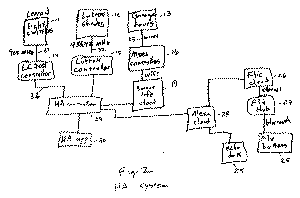
You can see the Raspberry Pi 5 computer here:
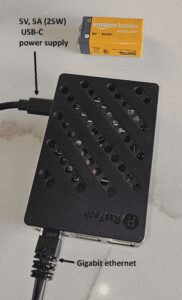
(The 9-volt battery is in the picture just for scale, to appreciate the diminutive form factor of the Raspberry Pi 5 computer.)
This HA path is not for the faint of heart. One must have some measure of tech-savviness and persistence to migrate over all of the various ecosystems in the house so that they learn how to communicate with the new HA controller (item 29 in Fig. 2).
The HA system was created by, and is supported by, a very energetic and productive group of volunteers. This reminds us of the many other areas in which free and open-source crowd-supported software systems have come to serve people quite well.
What I found was that in my own system migration, many of the proprietary ecosystems in my house were easy to migrate. It was only a few mouse clicks, for example, to teach the Lutron controller 15 how to communicate with the HA controller 29. The same was true for the garage door controllers 16 and for other systems in the house such as the thermostats. It was likewise just a few clicks to get the Alexa cloud 23 communicating with the HA controller 29.
The hardest migration, by far, was the Legrand migration. It turns out that two volunteers, Ross Tyler and Alexander Hudek, made it possible to succeed.
Mr. Tyler posted a body of code called 7001 Python interface on Github. Mr. Hudek drew upon Mr. Tyler’s code and optimized it for use with HA in a body of code called Home Assistant component for Legrand LC7001, also on Github. I was then able to load the latter body of code into my HA controller, told it the IP address of the LC7001 controller 14, and gave it the password for access to the LC7001 controller. Within seconds, the forty or so light switches in my house were visible in the HA system. Within seconds, I was able to use the HA app 30 to turn light switches on and off, turn dimmers up and down, and set up automations, scenes, and scripts. With a few more mouse clicks I was able to set things up so that “Alexa, please turn on the kitchen light” worked extremely reliably, for the first time in many years.
This is a delightful and satisfying result. Of course what made it possible was tens of thousands of hours of volunteer work to create HA, and still more volunteer work by Messrs. Tyler and Hudek to link HA to the LC7001 controller.
There are many other benefits to this HA migration, for example that now I can use a single HA app 30 instead of having to fumble through a dozen individual proprietary apps across a dozen ecosystems. I discuss these other benefits in this blog article.
If you wish to post a comment on this article, please do so here.
